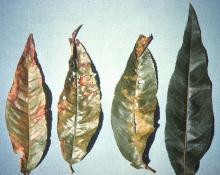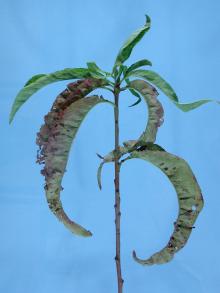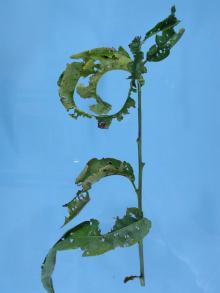See:
Cherry (Prunus spp.) - X-Disease
Cause A phytoplasma that is east of the Cascade Range and is spread by several leafhopper species, of which the most important is the geminate leafhopper, Colladonus geminatus. X-Disease can also be transmitted by budding, grafting or from an infected tree to a healthy tree through natural root grafts. Sweet and sour cherry also are susceptible to this organism. Candidatus Phytoplasma pruni is the suggested scientific name for the X-disease phytoplasma. Although several strains have been identified in other stone fruit, they all seem to induce similar symptoms in peach. Fruit quality and yield are reduced.
Once introduced into a tree the phytoplasma accumulates in the roots and then colonizes the tree systemically from the trunk upwards, accumulating in the lower branches first and then aerial scaffolds and limbs. Complete systemic infection can take several growing seasons after initial infection.
Several Prunus species are hosts including cherry, plum, bitter cherry and choke cherry. The phytoplasma can infect many other hosts including dandelion, mallow, apple and sagebrush. There are many similarities with peach yellows phytoplasma and peach rosette phytoplasm, both of which are quarantined against being brought into the PNW from Eastern States.
Peach yellow leafroll is a different phytoplasma (Candidatus Phytoplasma pyri) where symptoms overlap with those of X-disease but with this organism leaves do not shothole. This is the same pathogen that causes pear decline.
Symptoms Near the end of May, a few leaves show an irregular yellow spotting, which later may turn reddish or brown. Leaves tend to roll; infected tissue becomes necrotic and ultimately drops out in a rather ragged or shothole pattern. As the season advances, foliage from the stem base up shows these symptoms and drops to the ground; only young growth remains at the branches' tips. Spread appears to be from limb to limb throughout the tree. Fruit is delayed in maturity, smaller, lacks flavor, and may shrivel prematurely. Streaking of the fruit including red suture may also occur. Trees typically die in 4 to 8 years. Easily confused with the pear decline phytoplasma which causes peach yellow leaf roll.
Cultural control
- When X-Disease first appears, spray trees thoroughly to kill the vectors, and then remove infected trees. However, if many trees are infected, this may not be economically advisable because infected trees still can produce fruit that looks healthy.
- Establish new orchards only with nursery stock tested and found to be free of all known viruses and phytoplasmas. Do not source material from commercial orchards for nursery propagation.
- Apply insecticides for leafhopper management prior to tree removal and when mowing ground covers See PNW Insect Management Handbook for details.
- Remove wild chokecherry (Prunus demissa) or other hosts that can be a reservoir of the pathogen in the vicinity. A broadleaf herbicide program that promotes a healthy weed-free grass strip between tree rows will help result in a non-phytoplasma host environment. Reseach in 2018 did not find significant sources of X-disease in non-crop plants in and around orchards.
Reference Harper, S. J., Northfield, T. D., Nottingham, L. R., DuPont, S. T., Thompson, A. A., Sallato, B. V., Serban, C. F., Shires, M. K., Wright, A. A., Catron, K. A. and Marshall, A. T. 2023. Recovery Plan for X-Disease in Stone Fruit Caused by 'Candidatus Phytoplasma pruni'. Plant Health Progress, 24:258-295.
Molnar, C., Shires, M. K., Wright, A. A., Hoskins, M. C., Cowell, S. J., Nikolaeva, E. V., Knier, R., Nouri, M. T., Black, B. and Harper, S. J. 2024. Putting 'X'into context: the diversity of 'Candidatus Phytoplasma pruni'strains associated with the induction of X-disease. Plant Disease, 108:2677-2687.
Wright, A. A., Molnar, C., Shires, M. K., Bishop, G. and Harper, S. J. 2023. Physiological and Transcriptomic Analysis of 'Candidatus Phytoplasma pruni' Infection in Prunus persica. PhytoFrontiers, 3:323-336.




